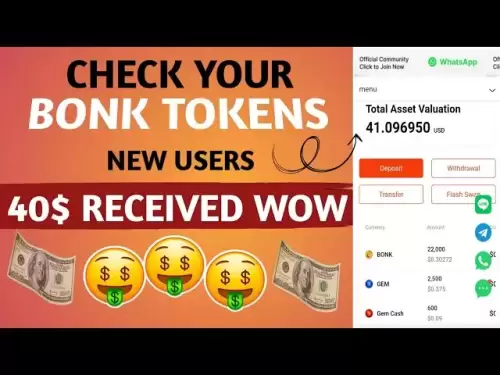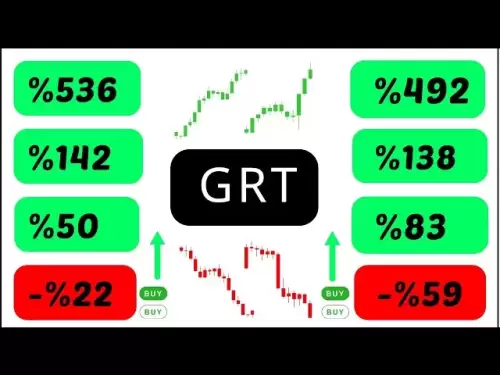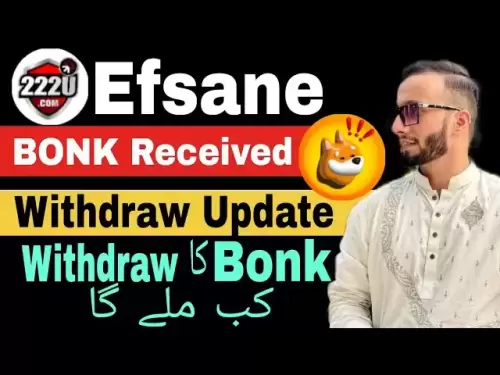-
 Bitcoin
Bitcoin $107,467.9126
1.26% -
 Ethereum
Ethereum $2,447.5288
-0.12% -
 Tether USDt
Tether USDt $1.0005
0.00% -
 XRP
XRP $2.1921
0.13% -
 BNB
BNB $647.2897
0.50% -
 Solana
Solana $144.8627
-0.37% -
 USDC
USDC $0.9996
-0.03% -
 TRON
TRON $0.2732
0.10% -
 Dogecoin
Dogecoin $0.1652
-0.18% -
 Cardano
Cardano $0.5700
-2.87% -
 Hyperliquid
Hyperliquid $37.0274
-1.81% -
 Bitcoin Cash
Bitcoin Cash $484.6957
0.19% -
 Sui
Sui $2.7354
-2.19% -
 Chainlink
Chainlink $13.1727
-1.49% -
 UNUS SED LEO
UNUS SED LEO $8.9978
-0.04% -
 Stellar
Stellar $0.2421
-2.33% -
 Avalanche
Avalanche $17.5633
-3.51% -
 Toncoin
Toncoin $2.8476
-1.94% -
 Shiba Inu
Shiba Inu $0.0...01166
-0.56% -
 Litecoin
Litecoin $85.1071
0.09% -
 Hedera
Hedera $0.1502
-2.96% -
 Monero
Monero $310.2774
-1.64% -
 Dai
Dai $0.9999
-0.01% -
 Polkadot
Polkadot $3.3584
-1.88% -
 Ethena USDe
Ethena USDe $1.0003
-0.04% -
 Bitget Token
Bitget Token $4.4443
2.90% -
 Pi
Pi $0.6242
14.04% -
 Uniswap
Uniswap $6.9774
-2.86% -
 Pepe
Pepe $0.0...09535
-5.05% -
 Aave
Aave $256.7574
-3.35%
How to see the DOT buy and sell depth? How to use the depth chart analysis?
To view DOT buy and sell depth, log into a crypto exchange like Binance, select your DOT pair, and click the "Depth" tab to analyze market liquidity and potential price movements.
May 06, 2025 at 09:07 am

Introduction to DOT Buy and Sell Depth
Understanding the buy and sell depth of a cryptocurrency like DOT (Polkadot) is crucial for traders who want to make informed decisions. The depth chart, also known as the order book depth, provides a visual representation of the supply and demand at different price levels. This article will guide you through the process of viewing the DOT buy and sell depth and how to effectively use the depth chart for analysis.
Where to View DOT Buy and Sell Depth
To view the DOT buy and sell depth, you need to access a reliable cryptocurrency exchange that supports Polkadot trading. Some popular exchanges include Binance, Kraken, and Huobi. Here's how you can view the depth chart on Binance as an example:
- Log into your Binance account and navigate to the trading section.
- Select the DOT trading pair you are interested in, such as DOT/USDT.
- Click on the "Depth" tab located at the top of the trading chart. This will display the depth chart for the selected trading pair.
Understanding the Depth Chart
The depth chart is typically displayed as a graph with two axes: the horizontal axis represents the price of DOT, while the vertical axis represents the cumulative volume of buy and sell orders. The chart is divided into two sections:
- The left side of the chart shows the buy orders, often colored in green. Each point on this side indicates the volume of DOT that traders are willing to buy at a specific price.
- The right side of the chart shows the sell orders, often colored in red. Each point on this side indicates the volume of DOT that traders are willing to sell at a specific price.
The intersection of these two sections represents the current market price of DOT.
How to Use the Depth Chart for Analysis
Analyzing the depth chart can provide valuable insights into market sentiment and potential price movements. Here are some key aspects to consider:
- Market Liquidity: A depth chart with a high volume of orders close to the current market price indicates high liquidity. This means you can buy or sell larger amounts of DOT without significantly impacting the price.
- Support and Resistance Levels: Areas with a high concentration of buy orders can act as support levels, where the price may find it difficult to drop below. Conversely, areas with a high concentration of sell orders can act as resistance levels, where the price may struggle to rise above.
- Imbalance in Buy and Sell Orders: If there is a significant imbalance between the buy and sell orders at certain price levels, it could signal an upcoming price movement. For example, if there are many more buy orders than sell orders, it might indicate that the price is likely to increase.
Practical Example of Depth Chart Analysis
Let's consider a practical example to illustrate how you can use the depth chart for analysis:
- Suppose you observe the DOT/USDT depth chart and notice a large volume of buy orders at $7.00. This suggests that many traders are willing to buy DOT at this price, which could act as a strong support level.
- If the current market price is $7.20 and there is a noticeable gap in sell orders between $7.20 and $7.50, it indicates that the price might rise to $7.50 before encountering significant resistance.
- If you see a sudden increase in sell orders at $7.30, it might be a signal that the price could face resistance at this level, potentially leading to a price drop.
Tips for Effective Depth Chart Analysis
To enhance your depth chart analysis, consider the following tips:
- Regularly Monitor the Depth Chart: Market conditions can change rapidly, so it's essential to keep an eye on the depth chart throughout the trading day.
- Combine with Other Indicators: While the depth chart provides valuable insights, it's beneficial to use it in conjunction with other technical indicators like moving averages, RSI, and MACD for a more comprehensive analysis.
- Be Aware of Market News: External factors such as regulatory news or updates from the Polkadot team can significantly impact the depth chart and market sentiment.
Common Mistakes to Avoid
When analyzing the DOT buy and sell depth, it's important to avoid common mistakes that can lead to misinterpretation:
- Overlooking the Overall Market Trend: The depth chart provides a snapshot of current orders, but it's crucial to consider the broader market trend to avoid misjudging potential price movements.
- Ignoring Volume: While the depth chart shows order volumes, it's also important to look at the trading volume to gauge the strength of market movements.
- Focusing Too Much on Small Price Levels: While it's tempting to zoom in on specific price levels, it's important to maintain a broader perspective to avoid getting caught up in minor fluctuations.
Frequently Asked Questions
Q: Can the depth chart predict future price movements accurately?
A: While the depth chart provides valuable insights into market sentiment and potential support and resistance levels, it cannot predict future price movements with absolute accuracy. It should be used as one of many tools in your trading arsenal.
Q: How often should I refresh the depth chart for the most accurate analysis?
A: It's recommended to refresh the depth chart at least every few minutes during active trading periods to stay updated with the latest market conditions. However, the frequency may vary depending on your trading strategy and the volatility of the market.
Q: Is it possible to automate depth chart analysis?
A: Yes, it is possible to automate depth chart analysis using trading bots and algorithms. These tools can monitor the depth chart and execute trades based on predefined criteria, but they require careful setup and monitoring to ensure they align with your trading strategy.
Q: How can I differentiate between genuine market orders and potential market manipulation on the depth chart?
A: Differentiating between genuine market orders and potential market manipulation can be challenging. Look for patterns such as sudden spikes in orders at specific price levels or large orders that appear and disappear quickly. Additionally, combining depth chart analysis with other market indicators and news can help you make more informed judgments.
Disclaimer:info@kdj.com
The information provided is not trading advice. kdj.com does not assume any responsibility for any investments made based on the information provided in this article. Cryptocurrencies are highly volatile and it is highly recommended that you invest with caution after thorough research!
If you believe that the content used on this website infringes your copyright, please contact us immediately (info@kdj.com) and we will delete it promptly.
- Pi Coin Price Prediction: June 26 - Will It Break $0.70?
- 2025-06-26 09:05:13
- Tokenization Takes Flight: Cross-Border Transactions Soar to New Heights
- 2025-06-26 08:30:12
- Midnight Airdrop: NIGHT Tokens and the Cardano-XRP Connection
- 2025-06-26 08:50:13
- DRML Miner & USDC: Cloud Mining Revolution in '25
- 2025-06-26 09:05:13
- DRML Miner, USDC, and Cloud Mining: What's the Buzz in 2025?
- 2025-06-26 09:30:12
- Barclays, Crypto, and Credit Cards: A Shifting Landscape
- 2025-06-26 09:10:14
Related knowledge

How to customize USDT TRC20 mining fees? Flexible adjustment tutorial
Jun 13,2025 at 01:42am
Understanding USDT TRC20 Mining FeesMining fees on the TRON (TRC20) network are essential for processing transactions. Unlike Bitcoin or Ethereum, where miners directly validate transactions, TRON uses a delegated proof-of-stake (DPoS) mechanism. However, users still need to pay bandwidth and energy fees, which are collectively referred to as 'mining fe...

USDT TRC20 transaction is stuck? Solution summary
Jun 14,2025 at 11:15pm
Understanding USDT TRC20 TransactionsWhen users mention that a USDT TRC20 transaction is stuck, they typically refer to a situation where the transfer of Tether (USDT) on the TRON blockchain has not been confirmed for an extended period. This issue may arise due to various reasons such as network congestion, insufficient transaction fees, or wallet-rela...

How to cancel USDT TRC20 unconfirmed transactions? Operation guide
Jun 13,2025 at 11:01pm
Understanding USDT TRC20 Unconfirmed TransactionsWhen dealing with USDT TRC20 transactions, it’s crucial to understand what an unconfirmed transaction means. An unconfirmed transaction is one that has been broadcasted to the blockchain network but hasn’t yet been included in a block. This typically occurs due to low transaction fees or network congestio...

How to check USDT TRC20 balance? Introduction to multiple query methods
Jun 21,2025 at 02:42am
Understanding USDT TRC20 and Its ImportanceUSDT (Tether) is one of the most widely used stablecoins in the cryptocurrency market. It exists on multiple blockchain networks, including TRC20, which operates on the Tron (TRX) network. Checking your USDT TRC20 balance accurately is crucial for users who hold or transact with this asset. Whether you're sendi...

What to do if USDT TRC20 transfers are congested? Speed up trading skills
Jun 13,2025 at 09:56am
Understanding USDT TRC20 Transfer CongestionWhen transferring USDT TRC20, users may occasionally experience delays or congestion. This typically occurs due to network overload on the TRON blockchain, which hosts the TRC20 version of Tether. Unlike the ERC20 variant (which runs on Ethereum), TRC20 transactions are generally faster and cheaper, but during...

The relationship between USDT TRC20 and TRON chain: technical background analysis
Jun 12,2025 at 01:28pm
What is USDT TRC20?USDT TRC20 refers to the Tether (USDT) token issued on the TRON blockchain using the TRC-20 standard. Unlike the more commonly known ERC-20 version of USDT (which runs on Ethereum), the TRC-20 variant leverages the TRON network's infrastructure for faster and cheaper transactions. The emergence of this version came as part of Tether’s...

How to customize USDT TRC20 mining fees? Flexible adjustment tutorial
Jun 13,2025 at 01:42am
Understanding USDT TRC20 Mining FeesMining fees on the TRON (TRC20) network are essential for processing transactions. Unlike Bitcoin or Ethereum, where miners directly validate transactions, TRON uses a delegated proof-of-stake (DPoS) mechanism. However, users still need to pay bandwidth and energy fees, which are collectively referred to as 'mining fe...

USDT TRC20 transaction is stuck? Solution summary
Jun 14,2025 at 11:15pm
Understanding USDT TRC20 TransactionsWhen users mention that a USDT TRC20 transaction is stuck, they typically refer to a situation where the transfer of Tether (USDT) on the TRON blockchain has not been confirmed for an extended period. This issue may arise due to various reasons such as network congestion, insufficient transaction fees, or wallet-rela...

How to cancel USDT TRC20 unconfirmed transactions? Operation guide
Jun 13,2025 at 11:01pm
Understanding USDT TRC20 Unconfirmed TransactionsWhen dealing with USDT TRC20 transactions, it’s crucial to understand what an unconfirmed transaction means. An unconfirmed transaction is one that has been broadcasted to the blockchain network but hasn’t yet been included in a block. This typically occurs due to low transaction fees or network congestio...

How to check USDT TRC20 balance? Introduction to multiple query methods
Jun 21,2025 at 02:42am
Understanding USDT TRC20 and Its ImportanceUSDT (Tether) is one of the most widely used stablecoins in the cryptocurrency market. It exists on multiple blockchain networks, including TRC20, which operates on the Tron (TRX) network. Checking your USDT TRC20 balance accurately is crucial for users who hold or transact with this asset. Whether you're sendi...

What to do if USDT TRC20 transfers are congested? Speed up trading skills
Jun 13,2025 at 09:56am
Understanding USDT TRC20 Transfer CongestionWhen transferring USDT TRC20, users may occasionally experience delays or congestion. This typically occurs due to network overload on the TRON blockchain, which hosts the TRC20 version of Tether. Unlike the ERC20 variant (which runs on Ethereum), TRC20 transactions are generally faster and cheaper, but during...

The relationship between USDT TRC20 and TRON chain: technical background analysis
Jun 12,2025 at 01:28pm
What is USDT TRC20?USDT TRC20 refers to the Tether (USDT) token issued on the TRON blockchain using the TRC-20 standard. Unlike the more commonly known ERC-20 version of USDT (which runs on Ethereum), the TRC-20 variant leverages the TRON network's infrastructure for faster and cheaper transactions. The emergence of this version came as part of Tether’s...
See all articles
























































































